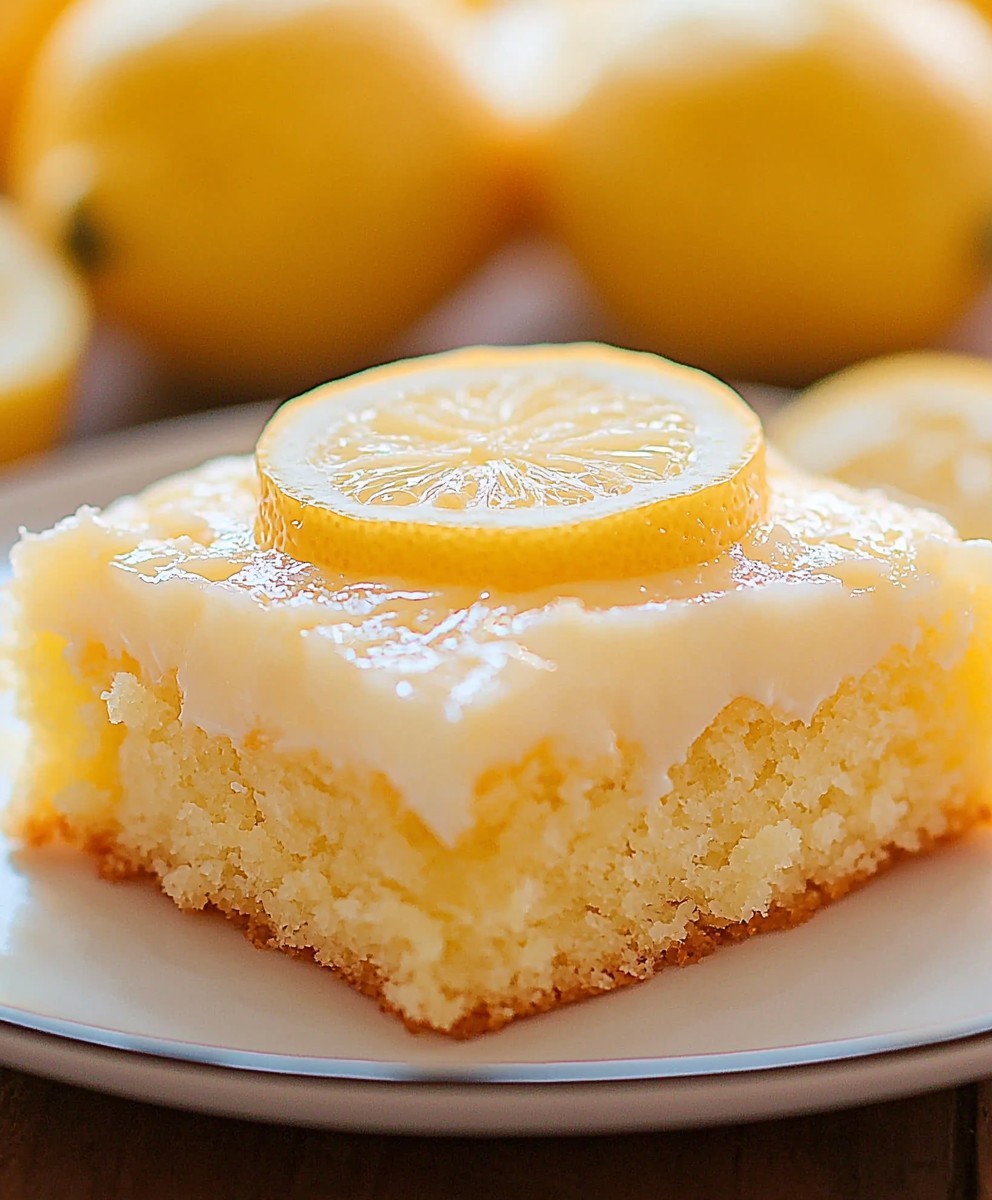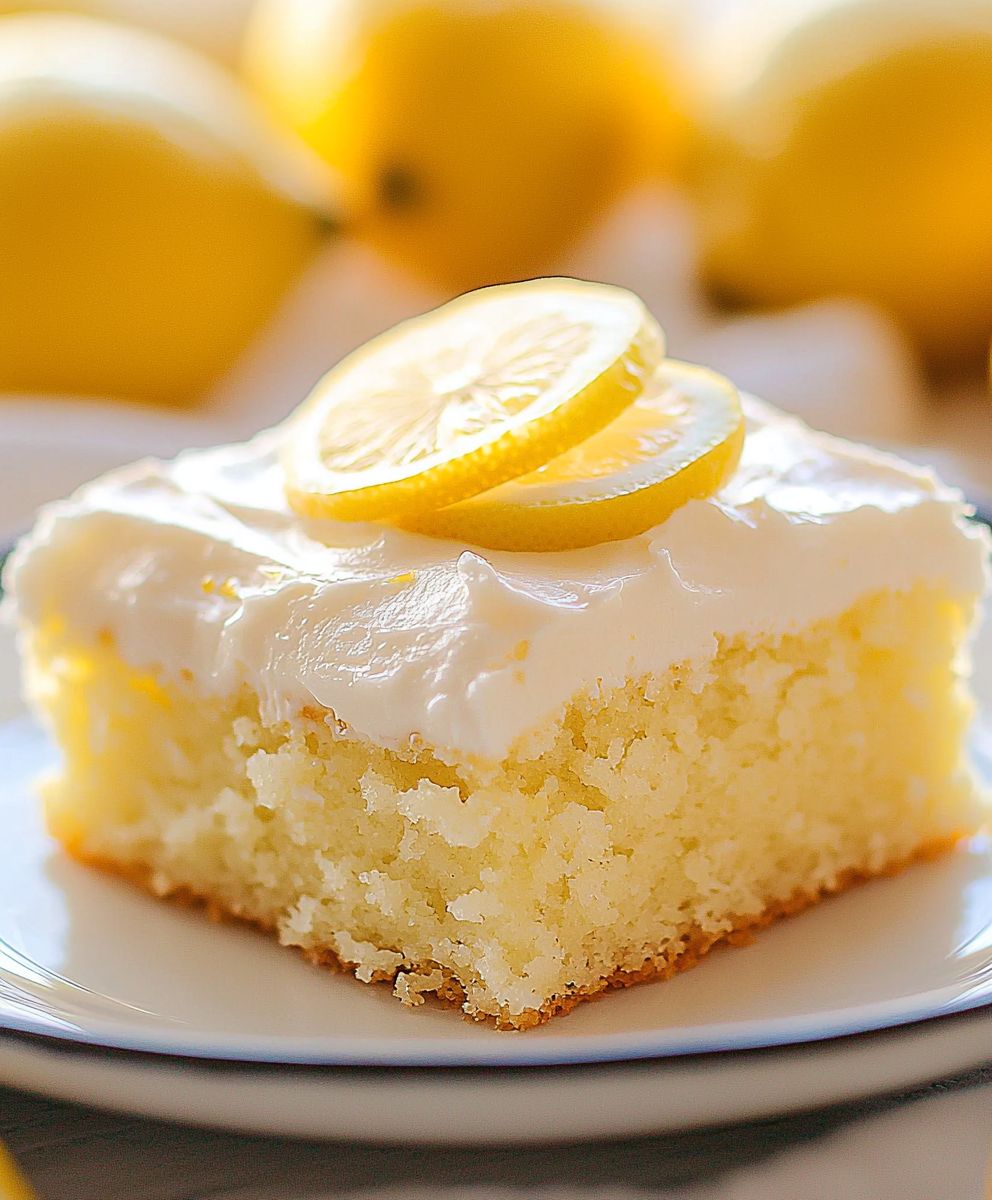Lemon Sheet Cake: Prepare to be transported to a sun-drenched citrus grove with every single bite! This isn’t just any cake; it’s a bright, tangy, and utterly irresistible dessert that’s perfect for everything from a casual afternoon tea to a celebratory gathering. Have you ever craved a dessert thats both incredibly easy to make and delivers a burst of sunshine in every mouthful? Then look no further!
Sheet cakes, in general, have a fascinating history, often associated with community gatherings and potlucks where ease of serving and sharing are paramount. But the addition of lemon elevates this simple concept to something truly special. The vibrant citrus fruit has been prized for centuries, not only for its refreshing flavor but also for its perceived health benefits and symbolic association with cleansing and renewal. Its no wonder that lemon-infused desserts have become a beloved staple in cuisines around the world.
People adore Lemon Sheet Cake for its delightful combination of flavors and textures. The moist, tender crumb, infused with the zesty aroma of fresh lemons, is perfectly balanced by a sweet and tangy glaze that seeps into every crevice. It’s a symphony of sweet and tart that dances on your tongue! Plus, the sheet cake format makes it incredibly convenient to bake and serve, making it a stress-free option for any occasion. Its a guaranteed crowd-pleaser that will leave everyone wanting more!

Ingredients:
- For the Cake:
- 3 cups all-purpose flour
- 1 teaspoon baking powder
- 1/2 teaspoon baking soda
- 1/4 teaspoon salt
- 1 cup (2 sticks) unsalted butter, softened
- 2 cups granulated sugar
- 4 large eggs
- 1/2 cup sour cream
- 1/4 cup lemon juice, freshly squeezed
- 2 tablespoons lemon zest, finely grated
- 1 teaspoon vanilla extract
- 1 cup buttermilk
- For the Lemon Glaze:
- 4 cups powdered sugar
- 1/2 cup lemon juice, freshly squeezed (more or less to reach desired consistency)
- 2 tablespoons unsalted butter, melted
- 1 tablespoon lemon zest, finely grated (optional, for extra lemon flavor)
Preparing the Cake Batter:
- Preheat and Prepare: First things first, preheat your oven to 350°F (175°C). While the oven is heating up, grease and flour a 13×18 inch sheet pan. Make sure you get into all the corners! This will prevent the cake from sticking and make it easier to remove later. I like to use baking spray with flour already in it for extra insurance.
- Combine Dry Ingredients: In a large bowl, whisk together the flour, baking powder, baking soda, and salt. Whisking is important to evenly distribute the leavening agents (baking powder and baking soda) throughout the flour. This ensures a light and airy cake. Set this bowl aside for now.
- Cream Butter and Sugar: In a separate, large mixing bowl (or the bowl of your stand mixer), cream together the softened butter and granulated sugar until light and fluffy. This usually takes about 3-5 minutes on medium speed. The mixture should become noticeably paler and increase in volume. This step is crucial for incorporating air into the batter, which contributes to the cake’s texture.
- Add Eggs: Beat in the eggs one at a time, making sure each egg is fully incorporated before adding the next. After adding all the eggs, scrape down the sides and bottom of the bowl to ensure everything is evenly mixed.
- Incorporate Sour Cream, Lemon Juice, Zest, and Vanilla: Add the sour cream, lemon juice, lemon zest, and vanilla extract to the butter and sugar mixture. Beat until just combined. Don’t overmix at this stage. The sour cream adds moisture and a slight tang, while the lemon juice and zest provide that signature lemon flavor.
- Alternate Adding Dry and Wet Ingredients: Gradually add the dry ingredients to the wet ingredients, alternating with the buttermilk. Begin and end with the dry ingredients. So, add about one-third of the dry ingredients to the wet ingredients and mix until just combined. Then, add half of the buttermilk and mix until just combined. Repeat with another third of the dry ingredients, the remaining buttermilk, and finish with the last third of the dry ingredients. Mix until just combined after each addition. Be careful not to overmix the batter, as this can develop the gluten in the flour and result in a tough cake.
- Pour into Pan: Pour the batter into the prepared sheet pan and spread it evenly with a spatula. Make sure the batter reaches all the corners of the pan.
Baking the Cake:
- Bake: Bake in the preheated oven for 20-25 minutes, or until a wooden skewer inserted into the center comes out clean. The cake should be golden brown on top and spring back lightly when touched.
- Cool: Remove the cake from the oven and let it cool completely in the pan on a wire rack. This is important because if you try to glaze the cake while it’s still warm, the glaze will melt and run off.
Preparing the Lemon Glaze:
- Combine Ingredients: In a medium bowl, whisk together the powdered sugar, lemon juice, melted butter, and lemon zest (if using) until smooth. Start with the specified amount of lemon juice and add more, one tablespoon at a time, until you reach your desired consistency. The glaze should be thick enough to coat the cake but thin enough to spread easily.
- Adjust Consistency: If the glaze is too thick, add a little more lemon juice. If it’s too thin, add a little more powdered sugar.
Glazing the Cake:
- Pour and Spread: Once the cake is completely cool, pour the lemon glaze over the top. Use a spatula to spread the glaze evenly over the entire surface of the cake.
- Let Set: Allow the glaze to set for at least 30 minutes before cutting and serving. This will give the glaze time to harden slightly and prevent it from being too sticky.
Tips and Variations:
- Lemon Extract: For an even more intense lemon flavor, you can add 1/2 teaspoon of lemon extract to the batter.
- Poppy Seeds: Add 2 tablespoons of poppy seeds to the batter for a Lemon Poppy Seed Sheet Cake.
- Berries: Top the cake with fresh berries, such as blueberries, raspberries, or strawberries, after glazing.
- Nuts: Sprinkle chopped nuts, such as almonds or pecans, over the glaze before it sets.
- Storage: Store the cake in an airtight container at room temperature for up to 3 days.
- Freezing: You can freeze the cake, unglazed, for up to 2 months. Wrap it tightly in plastic wrap and then in aluminum foil. Thaw overnight in the refrigerator before glazing.
- Gluten-Free Option: To make this cake gluten-free, substitute the all-purpose flour with a gluten-free all-purpose flour blend. Make sure the blend contains xanthan gum.
- Vegan Option: To make this cake vegan, substitute the butter with vegan butter, the eggs with flax eggs (1 tablespoon ground flaxseed mixed with 3 tablespoons water per egg), the sour cream with vegan sour cream, and the buttermilk with plant-based milk mixed with 1 tablespoon of lemon juice or apple cider vinegar.
Troubleshooting:
- Cake is dry: Make sure you are measuring the flour correctly. Spoon the flour into the measuring cup and level it off with a knife. Don’t pack the flour into the cup. Also, don’t overbake the cake.
- Cake is too dense: Make sure your baking powder and baking soda are fresh. Also, don’t overmix the batter.
- Glaze is too thin: Add more powdered sugar, one tablespoon at a time, until you reach the desired consistency.
- Glaze is too thick: Add more lemon juice, one teaspoon at a time, until you reach the desired consistency.
Enjoy your delicious Lemon Sheet Cake!

Conclusion:
This Lemon Sheet Cake isn’t just another dessert; it’s a ray of sunshine baked into a pan, and trust me, you absolutely need this recipe in your life. The bright, tangy lemon flavor, combined with the moist, tender crumb, creates a symphony of textures and tastes that will leave you craving more. Its incredibly easy to make, perfect for both seasoned bakers and kitchen novices alike, and the results are consistently impressive. Forget complicated recipes with finicky steps this sheet cake is all about delivering maximum flavor with minimal effort.
Why is it a must-try? Because it’s the perfect balance of sweet and tart, making it an ideal treat for any occasion. Whether you’re hosting a summer barbecue, celebrating a birthday, or simply want a delightful afternoon snack, this cake fits the bill. It’s also incredibly versatile. The simplicity of the recipe allows for endless customization, making it easy to tailor to your specific preferences.
Speaking of versatility, let’s talk serving suggestions and variations! For a classic presentation, simply dust the cooled cake with powdered sugar. The delicate sweetness of the sugar complements the lemon beautifully. Or, for an extra layer of flavor and visual appeal, consider making a simple lemon glaze. Combine powdered sugar with fresh lemon juice until you reach a smooth, pourable consistency, then drizzle it generously over the cake. You can even add a touch of lemon zest to the glaze for an extra burst of citrus.
If you’re feeling adventurous, try incorporating other flavors into the batter. A handful of fresh blueberries or raspberries would add a delightful fruity twist. You could also experiment with different citrus fruits, such as oranges or limes, for a unique flavor profile. For a richer, more decadent cake, try adding a layer of cream cheese frosting. The tangy cream cheese pairs perfectly with the lemon, creating a truly irresistible combination.
Another great serving suggestion is to pair a slice of this Lemon Sheet Cake with a scoop of vanilla ice cream or a dollop of whipped cream. The cool, creamy texture of the ice cream or whipped cream complements the warm, moist cake perfectly. You could also serve it with a side of fresh berries for a light and refreshing dessert.
Serving Suggestions:
- Dust with powdered sugar for a classic look.
- Drizzle with a lemon glaze for extra flavor.
- Top with fresh berries for a refreshing touch.
- Serve with vanilla ice cream or whipped cream for a decadent treat.
Variations:
- Add blueberries or raspberries to the batter.
- Substitute oranges or limes for the lemon.
- Use a cream cheese frosting for a richer cake.
I truly believe that this Lemon Sheet Cake will become a staple in your baking repertoire. It’s a crowd-pleaser that’s easy to make and always delivers delicious results. So, what are you waiting for? Preheat your oven, gather your ingredients, and get ready to bake a cake that will brighten your day.
I’m so excited for you to try this recipe! Once you’ve made it, I’d love to hear about your experience. Did you make any variations? What did you think of the flavor? Share your photos and comments below! Let’s spread the lemon love and inspire others to bake this delightful cake. Happy baking!
Lemon Sheet Cake: The Ultimate Guide to Baking Perfection
Bright, tangy lemon sheet cake with luscious lemon glaze. Perfect for parties, potlucks, or weeknight dessert!
Ingredients
- 3 cups all-purpose flour
- 1 teaspoon baking powder
- 1/2 teaspoon baking soda
- 1/4 teaspoon salt
- 1 cup (2 sticks) unsalted butter, softened
- 2 cups granulated sugar
- 4 large eggs
- 1/2 cup sour cream
- 1/4 cup lemon juice, freshly squeezed
- 2 tablespoons lemon zest, finely grated
- 1 teaspoon vanilla extract
- 1 cup buttermilk
- 4 cups powdered sugar
- 1/2 cup lemon juice, freshly squeezed (more or less to reach desired consistency)
- 2 tablespoons unsalted butter, melted
- 1 tablespoon lemon zest, finely grated (optional, for extra lemon flavor)
Instructions
- Preheat oven to 350°F (175°C). Grease and flour a 13×18 inch sheet pan.
- In a large bowl, whisk together the flour, baking powder, baking soda, and salt. Set aside.
- In a separate large bowl, cream together the softened butter and granulated sugar until light and fluffy (3-5 minutes).
- Beat in the eggs one at a time, ensuring each is fully incorporated before adding the next. Scrape down the bowl.
- Add the sour cream, lemon juice, lemon zest, and vanilla extract. Beat until just combined.
- Gradually add the dry ingredients to the wet ingredients, alternating with the buttermilk. Begin and end with the dry ingredients. Mix until just combined after each addition. Do not overmix.
- Pour the batter into the prepared sheet pan and spread evenly.
- Bake for 20-25 minutes, or until a wooden skewer inserted into the center comes out clean.
- Remove from oven and let cool completely in the pan on a wire rack.
- In a medium bowl, whisk together the powdered sugar, lemon juice, melted butter, and lemon zest (if using) until smooth. Adjust lemon juice to reach desired consistency.
- If the glaze is too thick, add a little more lemon juice. If it’s too thin, add a little more powdered sugar.
- Once the cake is completely cool, pour the lemon glaze over the top. Use a spatula to spread the glaze evenly.
- Allow the glaze to set for at least 30 minutes before cutting and serving.
Notes
- For an even more intense lemon flavor, you can add 1/2 teaspoon of lemon extract to the batter.
- Add 2 tablespoons of poppy seeds to the batter for a Lemon Poppy Seed Sheet Cake.
- Top the cake with fresh berries, such as blueberries, raspberries, or strawberries, after glazing.
- Sprinkle chopped nuts, such as almonds or pecans, over the glaze before it sets.
- Storage: Store the cake in an airtight container at room temperature for up to 3 days.
- Freezing: You can freeze the cake, unglazed, for up to 2 months. Wrap it tightly in plastic wrap and then in aluminum foil. Thaw overnight in the refrigerator before glazing.
- Gluten-Free Option: To make this cake gluten-free, substitute the all-purpose flour with a gluten-free all-purpose flour blend. Make sure the blend contains xanthan gum.
- Vegan Option: To make this cake vegan, substitute the butter with vegan butter, the eggs with flax eggs (1 tablespoon ground flaxseed mixed with 3 tablespoons water per egg), the sour cream with vegan sour cream, and the buttermilk with plant-based milk mixed with 1 tablespoon of lemon juice or apple cider vinegar.
- Cake is dry: Make sure you are measuring the flour correctly. Spoon the flour into the measuring cup and level it off with a knife. Don’t pack the flour into the cup. Also, don’t overbake the cake.
- Cake is too dense: Make sure your baking powder and baking soda are fresh. Also, don’t overmix the batter.
- Glaze is too thin: Add more powdered sugar, one tablespoon at a time, until you reach the desired consistency.
- Glaze is too thick: Add more lemon juice, one teaspoon at a time, until you reach the desired consistency.



